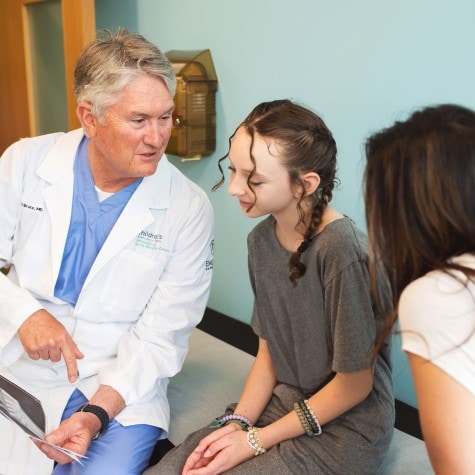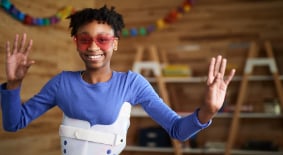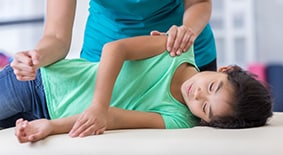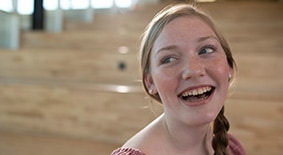Do You Think Your Child’s Spine Is Curved? They Might Have Scoliosis.
Our team at Children's Healthcare of Atlanta understands how to identify and treat scoliosis in infants, children, teens and young adults. We offer a wide range of care and treatment options that include bracing and surgery. If surgery is needed, our spine surgeons will use modern technology to speed healing and reduce complications.

As your child grows, so does their spine. And in most children, spines grow straight—but not always.
Sometimes as it grows, your child’s spine can bend to the side and may even twist or rotate. This “s” or “c” shape curve of the spine is a condition called scoliosis.
“There are a variety of treatments to deal with the effects of scoliosis," says Michael L. Schmitz, MD, Chief of Orthopedics and Sports Medicine at Children's, "and early detection is key.”
About 2-3% of kids have scoliosis, which is around 3 million new cases each year in the U.S. Most cases of scoliosis occur during early adolescence when growth spurts are common.
There are six common signs of scoliosis to look for in your child:
- Uneven shoulders and shoulder blades
- Unequal distance between the arms and body when standing
- Uneven hips
- Ribs that are prominent or stick out in one area
- Muscles that are prominent in the lower back or that bulge on one side
- Uneven skin folds at the waist
The good news is scoliosis is not always painful. Your child may not have pain at all, especially if the curve is mild or moderate.
How do you examine your child for the signs?
These five illustrations show you how to best look for the signs in your child. Remember, early detection broadens the range of available treatments. If scoliosis is discovered early, it can often be treated without surgery.
If you think your child may have scoliosis, talk to your child’s pediatrician and ask about getting a scoliosis screening. An X-ray will confirm a diagnosis of scoliosis, which is typically defined as a lateral, or sideways, curve of the spine of more than 10 degrees.
Early detection is important. While most kids with scoliosis will not have harmful long-term effects, some cases do result in serious problems later in life if not treated. Long-term complications could include:
- Obvious spinal deformity.
- Ongoing back pain.
- Heart and lung problems.
If your child has scoliosis, keep them healthy and confident by getting regular checkups and X-rays to monitor the size of the curve as your child grows. While scoliosis seems to affect girls and boys at the same rate, girls are seven to eight times more likely to develop a curve. The curve may get worse during the adolescent growth spurt, ages 9 to 13 in girls and ages 12 to 16 in boys. Once your child is fully grown, a mild curve (less than 30 degrees) will probably not worsen.
Treatment for scoliosis ranges from simply keeping an eye on your child’s spine to wearing a back brace or even corrective surgery in severe cases.

Where you take them matters.
Request an appointment with the only nationally ranked orthopedic program for kids and teens in Georgia, and we’ll help you understand your child’s diagnosis and create a comprehensive treatment plan.
Make an AppointmentMichael L. Schmitz, MD, is Chief of the Orthopaedics and Sports Medicine Center at Children’s Healthcare of Atlanta. He is also Co-Director of the Spasticity and Limb Deficiency clinics at Children’s, as well as the Medical Director of the Fracture Program.
This content is general information and is not specific medical advice. Always consult with a doctor or healthcare provider if you have any questions or concerns about the health of a child. In case of an urgent concern or emergency, call 911 or go to the nearest emergency department right away. Some physicians and affiliated healthcare professionals on the Children’s Healthcare of Atlanta team are independent providers and are not our employees.
Contact Us 404-255-1933











